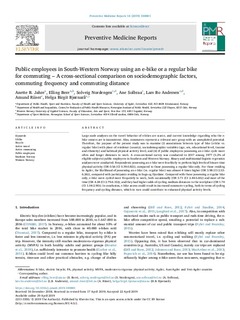| dc.contributor.author | Jahre, Anette B. | |
| dc.contributor.author | Bere, Elling Tufte | |
| dc.contributor.author | Nordengen, Solveig | |
| dc.contributor.author | Solbraa, Ane Kristiansen | |
| dc.contributor.author | Andersen, Lars Bo | |
| dc.contributor.author | Riiser, Amund | |
| dc.contributor.author | Bjørnarå, Helga Birgit | |
| dc.coverage.spatial | Norway | nb_NO |
| dc.date.accessioned | 2019-06-07T08:55:14Z | |
| dc.date.available | 2019-06-07T08:55:14Z | |
| dc.date.created | 2019-06-05T13:44:04Z | |
| dc.date.issued | 2019 | |
| dc.identifier.citation | Jahre, A. B., Bere, E., Nordengen, S., Solbraa, A., Andersen, L. B., Riiser, A., & Bjørnarå, H. B. (2019). Public employees in South-Western Norway using an e-bike or a regular bike for commuting – A cross-sectional comparison on sociodemographic factors, commuting frequency and commuting distance. Preventive Medicine Reports, 14. | nb_NO |
| dc.identifier.issn | 2211-3355 | |
| dc.identifier.uri | http://hdl.handle.net/11250/2600297 | |
| dc.description.abstract | Large-scale analyses on the travel behavior of e-bikes are scarce, and current knowledge regarding who the e-bike owners are is inconsistent. Also, commuters represent a relevant user group with an unexploited potential. Therefore, the purpose of the present study was to examine (i) associations between type of bike (e-bike vs. regular bike) with place of residence (county), sociodemographic variables (age, sex, educational level, income and ethnicity) and habitual physical activity level, and (ii) if public employees possessing an e-bike cycle more often and longer distances to work. A cross-sectional survey was conducted in 2017 among 1977 (5.2% of eligible subjects) public employees in Southern and Western Norway. Binary and multinomial logistic regression analyses were conducted. Respondents possessing an e-bike were less likely to perform high levels of leisure time physical activity (OR 0.56 (CI 0.39-0.82)), compared to those possessing a regular bike only. For those residing in Agder, the likelihood of possessing an e-bike (vs. regular bike) was almost 4 times higher (OR 3.98 (CI 2.53-6.26)), compared with participants residing in Sogn og Fjordane. Compared with those possessing a regular bike only, e-bike users cycled more frequently to work, both occasionally (OR 3.71 (CI 2.44-5.65)) and most of the time (OR 4.28 (CI 2.79-6.55)), and they had higher odds of cycling medium distances to the workplace (OR 1.74 (CI 1.04-2.90)). In conclusion, e-bike access could result in increased commuter cycling, both in terms of cycling frequency and cycling distance, which in turn could contribute to enhanced physical activity levels. | nb_NO |
| dc.language.iso | eng | nb_NO |
| dc.publisher | Elsevier | nb_NO |
| dc.rights | Navngivelse 4.0 Internasjonal | * |
| dc.rights.uri | http://creativecommons.org/licenses/by/4.0/deed.no | * |
| dc.subject | bicycle | nb_NO |
| dc.subject | active travel | nb_NO |
| dc.subject | active commuting | nb_NO |
| dc.subject | public employees | nb_NO |
| dc.subject | Southern Norway | nb_NO |
| dc.subject | Western Norway | nb_NO |
| dc.title | Public employees in South-Western Norway using an e-bike or a regular bike for commuting – A cross-sectional comparison on sociodemographic factors, commuting frequency and commuting distance | nb_NO |
| dc.type | Journal article | nb_NO |
| dc.type | Peer reviewed | nb_NO |
| dc.description.version | publishedVersion | nb_NO |
| dc.rights.holder | © 2019 The Author(s). | nb_NO |
| dc.source.pagenumber | 6 | nb_NO |
| dc.source.volume | 14 | nb_NO |
| dc.source.journal | Preventive Medicine Reports | nb_NO |
| dc.identifier.doi | 10.1016/j.pmedr.2019.100881 | |
| dc.identifier.cristin | 1702969 | |
| cristin.unitcode | 203,10,1,0 | |
| cristin.unitname | Institutt for idrett, kosthald og naturfag | |
| cristin.ispublished | true | |
| cristin.fulltext | original | |
| cristin.qualitycode | 1 | |

